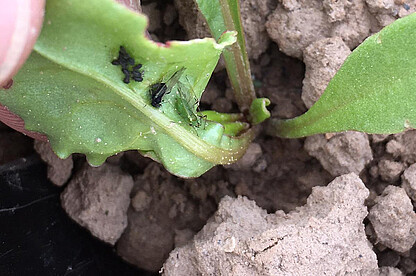Green peach aphid
In contrast to the black bean aphid, the green peach aphid occurs in much smaller numbers. The green peach aphid is dangerous for beet cultivation because it transmits yellowing viruses.





The green peach aphid (Myzus persicae) can transmit dangerous yellowing viruses to sugar beet during its sucking activity. The green peach aphid is rare, but the virus potential is much higher than that of the black bean aphid. The damage threshold until row closure is 10 % infested plants. Green peach aphid is found preferentially on the heart leaves inside the leaf rosette. As it seldom forms colonies, the plant must be closely examined for infestation.
Control: After the ban on neonicotinoid seed dressing in 2019, aphid monitoring (Nordzucker, LIZ) was established, starting at the end of April. After exceeding the damage threshold, an insecticide measure is necessary.
Several hundred plant species belong to the summer host plants of the green peach aphid. Besides sugar beet, potatoes, rape, cereals and many more are also colonised. The main host in winter is the peach.
The occurrence of the green peach aphid depends on winter temperatures and spring weather. The green peach aphid usually overwinters as an egg on the winter host, but live overwintering is also possible. In spring, initially unwinged aphids reproduce on the winter host, only the following generations are winged and fly to the summer host plants. On the winter hosts of the green peach aphid, the development and the time of flight to the summer hosts (sugar beet) can be observed.
Live overwintering in the anholo cycle has a particularly high pest potential because the aphids are viruses that cause yellowing: As soon as they colonise the sugar beet in spring, they infect the plants. The first aphid generations in the holocycle, which overwinter as eggs, are initially virus-free; they become infected with the yellowing viruses on contaminated plant material.

